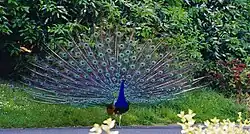孔雀
Chinese
| hole; surname | bird; lentigo; sparrow | ||
|---|---|---|---|
| simp. and trad. (孔雀) |
孔 | 雀 | |

Pronunciation
Synonyms
- (literary, or in compounds) 孔 (kǒng)
Derived terms
Japanese
Etymology 1
| Kanji in this term | |
|---|---|
| 孔 | 雀 |
| く Grade: S |
じゃく Jinmeiyō |
| goon | kan’yōon |
/kuᵑ sʲakʉ/ → /kuⁿzʲakʉ/ → /kuʑaku/
Ultimately from Middle Chinese 孔雀 (MC khuwngX tsjak).
First cited in the Wamyō Ruijushō of roughly 934.[1]
Noun
孔雀 or 孔雀 • (kujaku)
Usage notes
Derived terms
Derived terms
- 孔雀王 (Kujaku Ō)
- 孔雀王朝 (Kujaku Ōchō)
- 孔雀貝 (kujakugai)
- 孔雀経 (Kujaku-kyō)
- くじゃく座 (Kujaku-za)
- 孔雀サボテン (kujaku saboten)
- 孔雀羊歯 (kujaku shida)
- 孔雀絞り (kujaku shibori)
- 孔雀石 (kujakuseki)
- 孔雀草 (kujakusō)
- 孔雀染め (kujaku-zome)
- 孔雀炭 (kujakutan)
- 孔雀椿 (kujaku tsubaki)
- 孔雀の木 (kujaku no ki)
- 孔雀の間 (kujaku no ma)
- 孔雀鳩 (kujakubato)
- 孔雀檜葉 (kujaku hiba)
- 孔雀明王 (Kujaku Myōō)
- 孔雀椰子 (kujaku yashi)
- 印度孔雀 (Indo kujaku)
- 薄葉孔雀 (usuba kujaku)
- 沖縄孔雀 (Okinawa kujaku)
- 乙女孔雀 (otome kujaku)
- 小孔雀 (kokujaku)
- 白孔雀 (shirokujaku)
- 紅孔雀 (beni kujaku)
- 真孔雀 (makujaku)
- 舞孔雀 (maikujaku)
- 藪孔雀 (yabukujaku)
Idioms
- 孔雀の卵 (kujaku no tamago)
- 鳶が孔雀を生む (tobi ga kujaku o umu)
Etymology 2
| Kanji in this term | |
|---|---|
| 孔 | 雀 |
| く Grade: S |
さく > ざく Jinmeiyō |
| goon | |
/kuᵑ sakʉ/ → /kuⁿzakʉ/ → /kuzaku/
A variant shift from Middle Chinese 孔雀 (MC khuwngX tsjak).
First cited in the Utsubo Monogatari of roughly 999.[1]
See also
- ピーコック (pīkokku, “peacock”)
References
- Shōgaku Tosho (1988) 国語大辞典(新装版) [Unabridged Dictionary of Japanese (Revised Edition)] (in Japanese), Tōkyō: Shogakukan, →ISBN
- NHK Broadcasting Culture Research Institute, editor (1998), NHK日本語発音アクセント辞典 [NHK Japanese Pronunciation Accent Dictionary] (in Japanese), Tōkyō: NHK Publishing, →ISBN
- Matsumura, Akira, editor (2006), 大辞林 [Daijirin] (in Japanese), Third edition, Tōkyō: Sanseidō, →ISBN
This article is issued from Wiktionary. The text is licensed under Creative Commons - Attribution - Sharealike. Additional terms may apply for the media files.